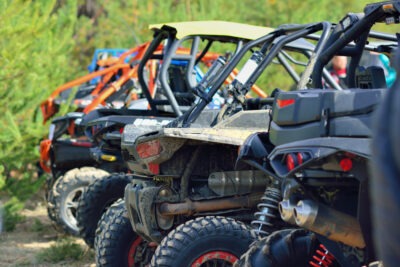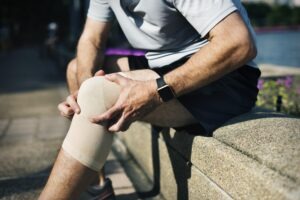
How is liability determined in a side-by-side (SXS) accident? It can be enjoyable to ride a side-by-side (SXS) vehicle, one of the many types of off-roading, all-terrain vehicles, but they can be very dangerous.
To determine liability with the assistance of an Atlanta ATV accident lawyer, you must demonstrate that someone should have kept you safe, and they failed to do so, causing an accident that led to your injuries.
Determining Liability in an Off-Roading Accident
Many factors play a role in who is liable in a side-by-side (SXS) accident. Who is involved, who is hurt, and what caused the accident are just a few of those factors.
Whenever possible, work with an Atlanta ATV accident lawyer who will start the process of determining liability by considering factors such as the following:
- Who was responsible for the SXS user and the use of it?
- What did that person do to make the other party safe or otherwise at risk?
- Did that action directly cause the accident that took place?
- Did the victim suffer injuries, including financial and physical injuries, from the accident?
Proving all four of these areas enables you to prove negligence happened. The key is to take a look at the various scenarios that could happen and apply this four-step logic to them. With the help of an Atlanta personal injury attorney, you will learn that there are various potential people responsible for accidents.
The Passenger of the SXS was Hurt
One potential situation occurs when the SXS driver causes an accident that injures the passenger in the vehicle. In this situation, it will be critical to prove that the passenger’s injuries were someone else’s fault. The most logical explanation would be that the reckless actions of the driver caused the accident, but there could be other factors to consider as well.
The Driver of the SXS Was Hurt When Borrowing the Vehicle
In another example, the driver of the SXS was hurt because the SXS vehicle broke down, causing them to suffer an injury. In this case, it may be the owner’s fault if you can show that the owner knew there was a risk to the condition of the vehicle or should have known and failed to take action to protect the driver. If someone fails to maintain the SXS and then allows someone else to use it, they could be held liable for the injuries.
The Driver Suffers an Injury from a Mechanical Failure
Perhaps the engine catches on fire, or a well-maintained vehicle suffers a serious failure that causes the accident to occur. If you can prove that there is a design defect in the vehicle or that the components were manufactured improperly, then the manufacturer could be held liable for the accident. Liability in a side-by-side (SXS) accident is determined based on whose oversight allowed the incident to happen.
The SXS Vehicle Accident was Due to Unsafe Conditions
The property owner may be held responsible if they allowed the vehicle to operate on their property and that property was not safe, perhaps with ditches or serious flooding. In these situations, if you can demonstrate that the owner knew or should have known about the risks but still allowed the rider to operate the vehicle, then the owner of the property could be held responsible. Proving the direct cause of the accident was the property itself can be challenging, but it is possible.
A Rented SXS Vehicle Breaks Down
Another example occurs when an SXS vehicle is rented out for a track or facility specifically designed for these types of actions and breaks down. In this case, the facility or rental provider’s owner could be held responsible for the injuries others suffer. The owner’s liability insurance may be used to cover the costs of the losses here.
Another Driver Hit the SXS on the Roadway
Though the legality of operating a low-speed vehicle on Georgia streets could prove to be a factor, if another vehicle driver strikes the rider and causes the accident, then that driver could be held responsible for the losses the SXS driver suffered, according to Georgia code: low speed vehicles.
For example, if the driver of a car is speeding or distracted and flies through a light, striking the SXS rider with the right of way, the car operator could be held responsible. It is critical to prove that you had the right to be on the road during these situations in order to show liability in a side-by-side (SXS) accident.
Get the strong arm
There are Times When the Driver is Responsible
When you work with an Atlanta ATV accident attorney, they will tell you frankly if anyone else may be responsible for your accident. There are times when you, as the driver, are responsible, especially if you engaged in reckless operation or simply did not have the experience to operate the vehicle. Your attorney will use evidence to prove this is not the case, including any of the following:
- Witness statements
- Accident recreation of the location and conditions
- Photos of the damage
- Videos of the use of the SXS
- Maintenance logs for the vehicle
- Property ownership surveys
There are a variety of ways that your Atlanta ATV accident attorney will try to prove that you were not responsible for what happened when it is possible under the law. If that is possible, your attorney will use the evidence obtained to demonstrate who caused the side-by-side (SXS) accident and, with it, who should pay for your injuries. Seeking out the help of an experienced and proven personal injury attorney with ATV experience is critical in complex cases like this, and our case results show that experience.
Schedule a Free, No-Risk Consultation with Our Attorney to Discuss Your Case
To determine how liability is decided in your side-by-side (SXS) accident, seek out the help of our personal injury attorney at John Foy & Associates. Allow our team to provide you with clarity on what your options are and what steps you can take to demonstrate someone else is at fault.
With decades of experience and a history of recovering millions of dollars for our clients, we will go to work to build your case as well, starting with a free consultation.
404-400-4000 or complete a Free Case Evaluation form





